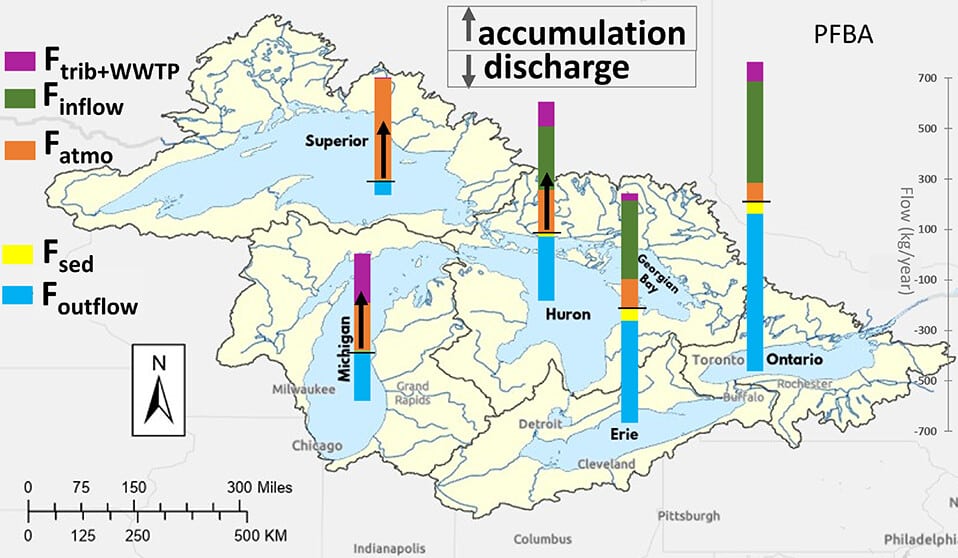PFAS or Perfluoroalkyl and Polyfluoroalkyl Substances are raining down on Lake Superior, contaminating its waters. A recent study published in Environmental Science and Technology reveals that rain has played a large role in spreading PFAS into all five Great Lakes. Commonly found in household products such as cleaners or personal care products, the chemicals resist breaking down in the environment. For this reason, agencies at the state level are implementing stronger controls, clean-up guidelines, and monitoring measures.

What are PFAS?
According to the U.S. Food and Drug Administration, PFAS are chemicals that resist grease, oil, water, and heat. Manufacturers first used them in the 1940s, and they now exist in hundreds of household products. These chemicals can enter the environment through various pathways, including rain, sewage water, and leaching from landfills. Due to their carbon-fluorine bond, they resist degradation.
Like microplastics, which were recently found in the Boundary Waters Canoe Area (BWCA), PFAS also adversely affect human and wildlife health. They have been linked to certain types of cancer, immune system challenges, and reproductive health issues. Even low levels of these chemicals can cause acute toxicity in fish.

Lake Superior impact
On average, Minnesotans consume roughly 3,720 million gallons of water from Lake Superior every day.
Although the study shows that Lake Superior has the lowest concentration of PFAS, its levels are increasing. Researchers from the Integrated Atmospheric Deposition Network collected and studied air and water samples over two years. The network enables the United States and Canada to jointly monitor the atmospheric contributions of toxic chemicals in the Great Lakes.
Hayley Hung, an atmospheric chemist at Environment and Climate Change Canada told EOS, “The Great Lakes Basin is one of our most important freshwater sources. This gives us an understanding of the extent of the contamination.”
In addition to rain, wastewater also plays a role in spreading PFAS into Lake Superior. Marianne Bohren, Executive Director of the Western Lake Superior Sanitary District, stated to WDIO, “It is discharged into the St. Louis Bay. She went on to add, “we treat approximately 13.9 billion gallons of wastewater each and every year, and approximately that value is what is discharged at the end of the plant.”
Meanwhile, as water treatment specialists conduct more studies and monitoring, methods are being tested to remove the chemicals from landfill leaching.

PFAS removal efforts
The Minnesota Pollution Control Agency (MPCA) issued a blueprint outlining both short and long-term strategies for preventing, managing, and cleaning up PFAS found throughout the state. Furthermore, they plan to prohibit the sale and distribution of consumer products intentionally containing PFAS by 2025.
MCPA commissioner, Katrina Kessler, stated, “PFAS are found in communities all over Minnesota and we must work together as state agencies and community partners to protect Minnesotans from this persistent environmental and human health challenge.”
Outdoor brands are starting to change their products in response to the issue. For example, some states are initiating a ban on these chemicals in most textiles by 2025. Manufacturers have used PFAS in gear like rain jackets, tent flies, water-resistant hiking boots, and fishing lines. Materials made with these chemicals are often labeled as “water-resistant,” “stain-resistant,” and “moisture-wicking.”
Ultimately, studying the impact of PFAS appears to be the first step in reducing pollution in freshwater lakes like Lake Superior. As researchers gain a clearer picture of transmission methods, they can target those sources to lower (and hopefully, eliminate) contaminants.
More info:
- Forever Chemicals Are Raining Down on the Great Lakes – EOS
- The Ins and Outs of Per- and Polyfluoroalkyl Substances in the Great Lakes: The Role of Atmospheric Deposition – ACS Publications
- PFAS Explained: These Forever Chemicals Are Being Banned from a Variety of Outdoor Products – Outdoor Life
- PFAS in fish – MNDNR
- 10 Things You Can Do About Toxic PFAS Chemicals – Clean Water Action

Wilderness guide and outdoorswoman Pam Wright has been exploring wild places since her youth. Remaining curious, she has navigated remote lakes in Canada by canoe, backpacked some of the highest mountains in the Sierra Nevada, and completed a thru-hike of the Superior Hiking Trail. Her professional roles include working as a wilderness guide in northern Minnesota and providing online education for outdoor enthusiasts.

